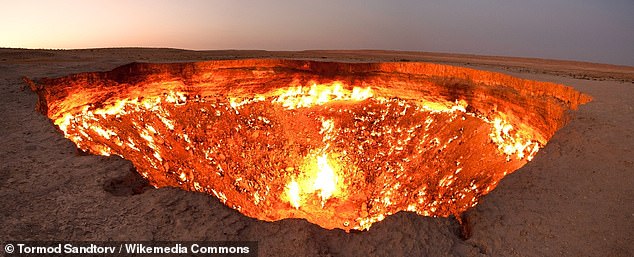[ad_1]
The infamous ‘Gateway to Hell’ crater in Turkmenistan has been burning non-stop for the last 50 years.
But scientists now say that the gateway is finally closing.
This blazing pit was formed in 1971 when blundering Soviet scientists accidentally drilled into an underground pocket of gas and decided to light it on fire.
Since then, the gateway has become both one of the reclusive nation’s leading tourist attractions and a major source of polluting methane emissions.
According to scientists, the flames in the crater are beginning to dim due to a reduced flow of natural flammable gas.
Officials say the fires are now three times smaller than in the past and can only be seen in the immediate vicinity.
Irina Luryeva, a director at state-owned energy company Turkmengaz told a fossil fuel conference this week: ‘Before a huge glow from the blaze was visible from several kilometres away, hence the name “Gateway to Hell”.
‘Today only a faint source of combustion remains.’

The infamous ‘Gateway to Hell’ has been burning since the 1970s, but scientists now say the gateway may be closing

The ‘Gateway to Hell’, known officially as the ‘Shining of Karakum’, is a 230-foot-wide (70m) sinkhole located in Turkmenistan’s Karakum desert. It is filled with fires fed by a vast underground reserve of natural gas
The ‘Gateway to Hell’, known officially as the ‘Shining of Karakum’, is a 230-foot-wide (70m) sinkhole located in Turkmenistan’s Karakum desert.
Located above a vast pocket of natural gas which continuously seeps towards the surface, the crater is lined with hundreds of gas fires which give it an unearthly glow.
The exact origin of the pit was covered up by officials when the country was part of the Soviet Union, leaving behind no official record of the incident.
However, the most commonly accepted theory is that the pit was created by a natural gas prospecting accident.
During the 1970s a rogue soviet gas drilling station punctured a gas pocket and collapsed through the ground, forming a crater which began to leak gas into the air.
The scientists decided to ignite the crater to prevent the toxic gases from escaping and spreading further.
While these scientists might have expected the blaze to last for a few days before going out, the fires of the Gateway to Hell have been burning ever since.
Turkmenistan is estimated to have the world’s fourth-largest reserves of natural gas, largely scattered in pockets beneath the desert.

It is believed that the pit formed when blundering Soviet scientists accidentally drilled into a pocket of gas hidden beneath the surface. To prevent the toxic gases from escaping, the scientists chose to light the pit on fire
The crater is likely connected to this vast underground store of methane, giving it an almost unlimited supply of gas to burn.
This burning pit caused by a Soviet-era disaster has become something of an unlikely national treasure.
Turkmenistan’s few tourists flock to the site to camp by the warmth of the burning methane and, in 2019, national leader Gurbanguly Berdymukhamedov filmed himself driving a rally car around the pit to dispel rumours of his death.
However, in 2022 Berdymukhamedov announced that he wanted to be remembered as the leader who closed the gates to hell and launched a project to cut off the fires.
Speaking at the time, Mr Berdymukhamedov said: ‘We are losing valuable natural resources for which we could get significant profits and use them for improving the well-being of our people.’
Since then, at least two new wells have been drilled around the pit to capture excess methane which would otherwise leak to the surface.
Older, decommissioned gas pumps in the area have also been reactivated to help draw away the natural gas.
According to the evidence from these nearby wells, the crater has seen a significantly reduced supply of gas.

Since 2022, officials have drilled several new gas wells near the pit in order to draw away the gas which feeds the fires

According to officials, the flames are now three times smaller and can only be seen in the local vicinity
This, in turn, has led to the infamous flames dwindling in size.
The announcement will come as good news to environmentalists concerned about Turkmenistan’s record of natural gas leaks.
Methane is a highly potent greenhouse gas which contributes heavily to climate change.
A recent study published by the International Energy Agency found that Turkmenistan was the world’s largest emitter of methane through gas leaks, although the country disputes this claim.
Likewise, intelligence company Kayrros found that leaks from two fossil fuel fields in the country contributed more to global warming in 2022 than the UK’s entire carbon emissions for the year.
While the fires at the Gateway to Hell did help burn off some of the escaping gas, the pit still leaks vast quantities of gas into the atmosphere.
Drawing off the natural gas into other wells where it can be safely stored and used to make energy would help the country cut its outsized carbon footprint.
[ad_2]
This article was originally published by a www.dailymail.co.uk . Read the Original article here. .

